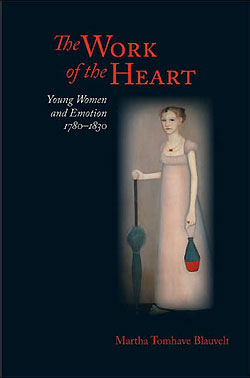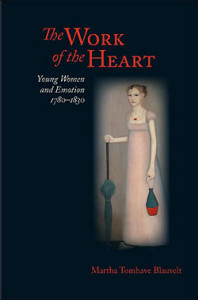Emotional Labors

Lucid, accessible, succinct, and richly illuminating, Martha Tomhave Blauvelt’s The Work of the Heart considers the emotional life of young, white, single, northeastern women of the middle and upper classes in the early American republic. Blauvelt focuses in particular on diaries, which are especially revealing in that they were a new genre in which to represent the self. “Between 1780 and 1830,” Blauvelt writes, “the journal of sensibility emerged and flourished as a distinctive category of first-person narrative for young American women” (15).
In her reading of these first-person narratives, Blauvelt finds that women displayed the new manners redolent of the new selfhoods they fashioned. Drawing on British conduct books, expurgated versions of Lord Chesterfield’s letters to his son chief amongst them, the women’s diaries document how they performed the values of the new gentility of the early republic. Blauvelt argues that gentility for these women could be “summed up in three popular and interlocking eighteenth-century words: delicacy, sensibility, and taste. ‘Delicacy in the larger sense meant the capacity for fine discriminations and an appreciation for all that was refined and gentle,’ while sensibility was the emotional expression of delicacy, and taste comprised the indefinable but crucial ability to convey delicacy and sensibility in beautiful forms” (18). The material and emotional aspects of gentility fused into one, and refinement in manner and material possessions began to connote sympathy rather than selfishness. As “warmhearted gentility succeeded coldhearted aristocracy,” the young women managed to hold onto their republican identities even as they modeled themselves on British etiquette (20-21). The journals illuminate the various ways in which the women negotiated the myriad social roles and functions they embodied and the “emotional communities” the women inhabited. Moreover, the journals provide an opportunity to observe two types of social “acting” directly related to what Arlie Russell Hochschild has called “emotion work”: “surface acting” (purposeful body language) and “deep acting” (the construction of authentic feeling, of feeling itself).
One of the most crucial contributing factors to the special character of the women’s “emotion work” was sentimental literature, especially the novel but also verse and essays. Such writing facilitated both the women’s own interior emotional discussions and those that they had with one another. This common literature informed the lives of women, crucially enhancing the new peer culture of the republic, a hallmark of which was the exchange of works of sensibility. Novels in the sentimental and also the gothic genres were especially irresistible and compelling; several journal entries cited by Blauvelt describe the women’s inability to put such books down. The novels reflected the women’s fantasies and feelings, but they also enabled “young women to more fully possess feelings of sensibility,” potentially easing “the conflict between spontaneity and performance” (32). Reading was a moral activity even as it gave license to the expression of often skeptically regarded passionate responses. The women of sensibility were expected to feel but not to feel too much—”emotion work involved suppressing feeling as much as producing it”—and late-eighteenth-century culture, despite all of its variegated thinking, united on the belief in the crucial importance of self-control (34). It was important not just to control but to eradicate the self.
Sensibility allowed women to negotiate both their romantic (heterosexual) relationships and their same-sex friendships. But it also, perhaps most powerfully, allowed them to negotiate their perceptions of themselves. “The core of sensibility,” Blauvelt writes, “was not in fact empathy, but the use of others’ experiences in order to stimulate and admire one’s own feelings and, in that sense, it required its devotees to be attentive to themselves, not just to others” (47). The diaries assert the importance of the self as subject; such “self-admiration suggests another metaphor for sensibility: it acted not just as a theater, but as a mirror” (48). Such narcissistic self-regard would be strongly curtailed in American culture from its beginnings. Sarah Pierce, founder of the Litchfield Female Academy in Connecticut, would write that “selfishness is the great destroyer of human happiness” (53). Concomitantly, the journal writing of her students entailed “self-suppression rather than self-expression: ‘Do not let great I occupy too great a share of your Journals,’ Sarah Pierce cautioned” (54).
Perhaps the most ambivalent aspect of women’s intellectual training was its ineluctable trajectory into the one available future for women: the marriage plot, as Carolyn Heilbrun termed it (associating the “quest plot” with men). The art of finding a husband challenged women to exercise “all their emotional skills” and also “promised women more agency than in any other period of their lives” (81). Blauvelt illuminates the hazards of courtship, in which young women had to put all of their finely honed skills to the ultimate test, distinguishing good and loving men from hypocrites—or worse. Far from being a halcyon time of tender passions and fragrant flatteries, courtship necessarily transformed women into shrewd appraisers of men’s worth. The woman who succeeded in the peculiar ars erotica that led to marriage in the early republic was the woman “who recognized that often emotion was no more than a performance, especially for men” (92).
“Unlike the fluid shifting of their girlhood,” Blauvelt writes, “irrevocable events marked the world of mature womanhood.” She highlights four paths that marked this emotional transition: “religious commitment, marriage, motherhood, and traumatic encounters with death” (147). Blauvelt argues that these signal events in women’s more mature years led to a loss of interest in the novel, the literary genre that seemed to speak most urgently to them in their teenage years. The later diaries (when time permitted these women to write), also evince a “lack of anger, sarcasm, and wit” (163). Along with conscription into normative roles appeared to come a loss of the tools of distinctive personality, to say nothing of the fires that fueled it. And religion provided ambiguous comfort for the loss of personality. Conversion, writes Blauvelt, “provided no lasting assurance of emotional congruity.” Instead, it “inaugurated a lifetime of emotion work rather than the ease of identity they sought” (179). Throughout their lives, women experienced emotion as work; even a child’s death called for the expression of grief that pointedly did “not give way to intense feeling” (179).
Blauvelt provides us with a moving, insightful, and valuable study of women’s emotional management in the early republic that reenergizes the field of early American women’s history. I do, however, have some reservations about her work. For a study that devotes so much time and attention to emotion as a performance, the book never engages with performance studies save for its uses of Erving Goffman, whose 1959 study The Presentation of Self in Everyday Life is widely considered the foundation of the theory. It would have been interesting and more intellectually daring to see Blauvelt push the theoretical boundaries of her study further.
But this lacuna also reveals another gap: for a study concerned with courtship rituals, Blauvelt’s book pays very little attention to the question of female sexuality and certainly very little to the question of same-sex desire, which would seem relevant not just in terms of the homosocial atmosphere of environments such as the female academy but also in terms of the scholarship that has been done on same-sex ties in this era. Blauvelt raises the scholarship on same-sex ties only to retreat from it. Yet how can one talk about emotions and not consider the role sexuality might play in shaping these emotional responses? In relegating the discussion of sexuality to the sidelines, Blauvelt leaves her study frustratingly incomplete; it is a measure of her success that Work of the Heart survives this considerable lapse.
This article originally appeared in issue 9.3 (April, 2009).
David Greven is an assistant professor of English at Connecticut College. He is the author of Manhood in Hollywood from Bush to Bush (2009) and Men Beyond Desire: Manhood, Sex, and Violation in American Literature (2005). His essays have appeared in such journals as American Quarterly, Studies in American Fiction, Refractory, Genders, Poe Studies, and The Nathaniel Hawthorne Review. His current book project is called Oneness Inscrutable: Hawthorne’s Fiction and Freudian Theory.
